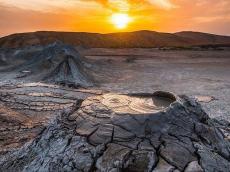Today.Az » Society » Azerbaijan kicks off project to research mud volcanoes scientifically
18 July 2022 [11:34] - Today.Az

By Azernews By Laman Ismayilova Mud volcanoes in Azerbaijan have been taken under scientific control, Azernews reports. Speaking with journalists, Vice-President of the National Academy of Sciences Ibrahim Guliyev said that the work is being carried out within the project implemented with the funds of an international grant won by the academy. The National Academy of Sciences has installed 22 stations - special sensors, including those around volcanoes. "The grant is related to the expansion of the seismic network in the Caucasus and Central Asia. Around 60 stations will be delivered, including ours in the Caspian Sea, as well as on mud volcanoes," the academician said. He noted that more than half of the 1,300 mud volcanoes in the world are located in Azerbaijan, and almost a third of them are in the Azerbaijani sector of the Caspian Sea. "All of our major oil infrastructures are offshore. There are 3-4 volcanoes in all our fields (Azeri-Chirag-Gunashli, Shah Deniz). Therefore, the monitoring of volcanoes is a separate issue. Unfortunately, an attempt to create earthquake warning systems in the sea turned out to be a failure, which cannot be said about mud volcanoes. Now we are installing special seismic sensors on the Caspian coastline and around volcanoes to observe them," said Guliyev. Azerbaijan is home to some stunning and unique natural wonders. The Land of Fire has the most significant number of mud volcanoes worldwide. At present, there are 365 mud volcanoes in Azerbaijan. Most volcanoes are active, and 43 of them are protected by the Azerbaijan Ministry of Ecology and Natural Resources. For security reasons, the admission of people is prohibited. Until the end of 2019, Azerbaijani scientists expect several volcanic eruptions, including Bozdag-Gobu volcanoes in Absheron district, Bahar in Alat village, and Shikhzahirli volcano in Gobustan. Tourists can get a unique panoramic view of the spectacular natural wonder in the Gobustan State Historical-Artistic Reserve. The world’s largest mud volcanoes - Boyuk Khanizadagh and Turaghai - are both in Azerbaijan. Boyuk Khanizadagh erupted on October 10, 2001, shooting out flames for 300 meters in the air. It was the highest record for flames shot from a mud volcano. NASA geologists studying Mars concluded that the mud volcanoes of Azerbaijan are similar to the uplands of the planet in their structure. On September 5, 2004, the largest mud volcano in the territory of Azerbaijan was added to the Guinness World Records. Azerbaijan's rich fields of oil and gas condensate such as Lokbatan, Garadagh, Oil Rocks, and Mishovdag were also discovered near mud volcanoes. The lava, mud, and liquid spewed by mud volcanoes are used as raw materials for chemical and construction industries, as well as pharmacology. Enriched with specific components - mineral salts, organic substances, microelements, volcanic mud has medicinal properties that have a beneficial effect on the human body. Volcanic mud greatly affects the treatment of patients suffering from diseases of the peripheral and central nervous system, gastrointestinal tract, skin, etc.
|